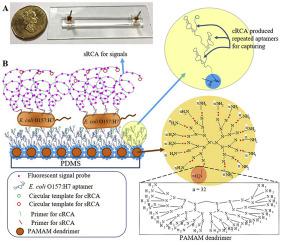当前位置:
X-MOL 学术
›
Anal. Chim. Acta
›
论文详情
Our official English website, www.x-mol.net, welcomes your
feedback! (Note: you will need to create a separate account there.)
Developing a dual-RCA microfluidic platform for sensitive E. coli O157:H7 whole-cell detections
Analytica Chimica Acta ( IF 5.7 ) Pub Date : 2020-08-01 , DOI: 10.1016/j.aca.2020.06.046 Yuqian Jiang 1 , Zhenyu Qiu 2 , Tao Le 3 , Shan Zou 4 , Xudong Cao 5
Analytica Chimica Acta ( IF 5.7 ) Pub Date : 2020-08-01 , DOI: 10.1016/j.aca.2020.06.046 Yuqian Jiang 1 , Zhenyu Qiu 2 , Tao Le 3 , Shan Zou 4 , Xudong Cao 5
Affiliation

|
Aptamer based microfluidic platforms have been developed rapidly in recent years, and strategies to improve detection sensitivities of such platforms have attracted a significant amount of attention. To achieve whole cell sensitive detections by microfluidic devices, a new dual-rolling circle amplification (RCA) detection approach is presented in this study. This dual-RCA approach includes a capturing RCA (cRCA) reaction that is designed to modify microfluidic channel surfaces with long tandem repeating aptamers (i.e. poly-aptamers) to effectively capture target E. coli O157:H7 cells. We demonstrate that this poly-aptamers modified microchannels capture 3-fold more target cells in comparison with microchannels modified with mono-aptamers against the target cells. In addition, signalling RCA (sRCA) is employed in the dual-RCA design to further enhance detection signals. Our results show that the detection signals are enhanced by up to 50 times by sRCA when compared with those with single fluorescence probes. Furthermore, by combing both the cRCA and the sRCA in one dual-RCA detection system, we demonstrate that the detection signals can be significantly enhanced by ∼250-fold. We also show that E. coli O157:H7 detections with the dual-RCA approach can be used in different food matrices, including orange juice and milk where the limit of detection of 80 cells/mL is achieved. In conclusion, this microfluidic device in combination with a dual-RCA to enhance both target capturing and detection signals is a simple and promising approach to sensitive whole-cell detections for food safety inspections.
中文翻译:

开发用于敏感大肠杆菌 O157:H7 全细胞检测的双 RCA 微流体平台
近年来,基于适体的微流体平台发展迅速,提高此类平台检测灵敏度的策略引起了广泛关注。为了通过微流体装置实现全细胞敏感检测,本研究提出了一种新的双滚环扩增 (RCA) 检测方法。这种双 RCA 方法包括捕获 RCA (cRCA) 反应,该反应旨在用长串联重复适体(即聚适体)修饰微流体通道表面,以有效捕获目标大肠杆菌 O157:H7 细胞。我们证明,与用针对靶细胞的单适体修饰的微通道相比,这种多适体修饰的微通道捕获的靶细胞多 3 倍。此外,双 RCA 设计中采用信号 RCA (sRCA) 以进一步增强检测信号。我们的结果表明,与单个荧光探针相比,sRCA 的检测信号增强了多达 50 倍。此外,通过在一个双 RCA 检测系统中结合 cRCA 和 sRCA,我们证明检测信号可以显着增强约 250 倍。我们还表明,使用双 RCA 方法检测大肠杆菌 O157:H7 可用于不同的食品基质,包括橙汁和牛奶,检测限达到 80 个细胞/mL。总之,这种微流体装置与双 RCA 相结合以增强目标捕获和检测信号,是一种简单而有前途的方法,可用于食品安全检查的灵敏全细胞检测。我们的结果表明,与单个荧光探针相比,sRCA 的检测信号增强了多达 50 倍。此外,通过在一个双 RCA 检测系统中结合 cRCA 和 sRCA,我们证明检测信号可以显着增强约 250 倍。我们还表明,使用双 RCA 方法检测大肠杆菌 O157:H7 可用于不同的食品基质,包括橙汁和牛奶,检测限达到 80 个细胞/mL。总之,这种微流体装置与双 RCA 相结合以增强目标捕获和检测信号,是一种简单而有前途的方法,可用于食品安全检查的灵敏全细胞检测。我们的结果表明,与单个荧光探针相比,sRCA 的检测信号增强了多达 50 倍。此外,通过在一个双 RCA 检测系统中结合 cRCA 和 sRCA,我们证明检测信号可以显着增强约 250 倍。我们还表明,使用双 RCA 方法检测大肠杆菌 O157:H7 可用于不同的食品基质,包括橙汁和牛奶,检测限达到 80 个细胞/mL。总之,这种微流体装置与双 RCA 相结合以增强目标捕获和检测信号,是一种简单而有前途的方法,可用于食品安全检查的灵敏全细胞检测。
更新日期:2020-08-01
中文翻译:

开发用于敏感大肠杆菌 O157:H7 全细胞检测的双 RCA 微流体平台
近年来,基于适体的微流体平台发展迅速,提高此类平台检测灵敏度的策略引起了广泛关注。为了通过微流体装置实现全细胞敏感检测,本研究提出了一种新的双滚环扩增 (RCA) 检测方法。这种双 RCA 方法包括捕获 RCA (cRCA) 反应,该反应旨在用长串联重复适体(即聚适体)修饰微流体通道表面,以有效捕获目标大肠杆菌 O157:H7 细胞。我们证明,与用针对靶细胞的单适体修饰的微通道相比,这种多适体修饰的微通道捕获的靶细胞多 3 倍。此外,双 RCA 设计中采用信号 RCA (sRCA) 以进一步增强检测信号。我们的结果表明,与单个荧光探针相比,sRCA 的检测信号增强了多达 50 倍。此外,通过在一个双 RCA 检测系统中结合 cRCA 和 sRCA,我们证明检测信号可以显着增强约 250 倍。我们还表明,使用双 RCA 方法检测大肠杆菌 O157:H7 可用于不同的食品基质,包括橙汁和牛奶,检测限达到 80 个细胞/mL。总之,这种微流体装置与双 RCA 相结合以增强目标捕获和检测信号,是一种简单而有前途的方法,可用于食品安全检查的灵敏全细胞检测。我们的结果表明,与单个荧光探针相比,sRCA 的检测信号增强了多达 50 倍。此外,通过在一个双 RCA 检测系统中结合 cRCA 和 sRCA,我们证明检测信号可以显着增强约 250 倍。我们还表明,使用双 RCA 方法检测大肠杆菌 O157:H7 可用于不同的食品基质,包括橙汁和牛奶,检测限达到 80 个细胞/mL。总之,这种微流体装置与双 RCA 相结合以增强目标捕获和检测信号,是一种简单而有前途的方法,可用于食品安全检查的灵敏全细胞检测。我们的结果表明,与单个荧光探针相比,sRCA 的检测信号增强了多达 50 倍。此外,通过在一个双 RCA 检测系统中结合 cRCA 和 sRCA,我们证明检测信号可以显着增强约 250 倍。我们还表明,使用双 RCA 方法检测大肠杆菌 O157:H7 可用于不同的食品基质,包括橙汁和牛奶,检测限达到 80 个细胞/mL。总之,这种微流体装置与双 RCA 相结合以增强目标捕获和检测信号,是一种简单而有前途的方法,可用于食品安全检查的灵敏全细胞检测。











































 京公网安备 11010802027423号
京公网安备 11010802027423号